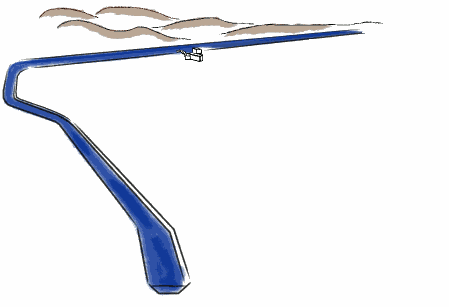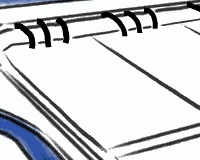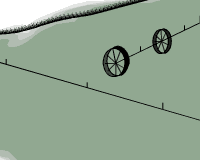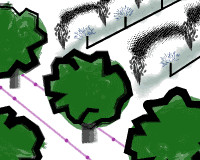- Reclamation
- California-Great Basin
- WaterShare
- Resources
- AgriWater
AgriWater
Managing Water on the Farm
The idealized farm shown here illustrates the three basic irrigation methods:
- Gravity flow surface irrigation
- Pressurized sprinkler irrigation
- Low pressure micro irrigation

What You Will Learn:
- How each application method works -- operations
- When it works well -- best management practices
- What the costs and benefits are -- economics
Keep in mind that there is no one best irrigation method for all conditions. Any method can work efficiently if it is appropriate to the circumstances, well designed, and diligently maintained. In all cases, the proper application amount equals the water required by the crop, plus the water needed to prevent the build-up of harmful minerals in the soil through a process called leaching.
Water, like any other developed resource, comes at a cost even as it provides benefits. Agriculture, like other business, seeks to minimize costs while maximizing benefits. Good irrigation management can shift environmental effects from the cost side to the benefit side of the economic ledger while improving farm operations at the same time. A win-win solution.
Gravity Flow Surface Irrigation
How It Works:
Water spreads over a basin or along furrows by gravity flow. Earthen borders check the spread. There may be pumps at the tail end of the field to recycle excess water (if there is any).
Typical Crops:
Basin: hay, grain, pasture
Furrow: cotton, tomatoes, corn, cabbage, sugar beets

Basin irrigation
When It Works Well:
Fields should be prepared so they are level or slightly and evenly sloped. A farmer can calculate the amount of water to apply (irrigation scheduling) by noting the field dimensions, crop, stage of growth, climate conditions, and soil dryness. The objective: Minimize the water lost beyond the reach of plant roots, and the excess water pumped from the tail end of sloped fields.
Costs and Benefits:
Farmers close to rivers can drain their excess tail water to the natural channel or let extra water percolate below the plant roots underground back to the river, thus helping to replenish the QUANTITY of the river's flow. However, the return water carries sediment, soil salts, chemicals, and fertilizer, all of which diminish the water QUALITY in the receiving stream. Careful water scheduling benefits the environment by reducing both diversions and runoff. Since less water is diverted, less power is required to pump water to the fields.
Pressurized Sprinkler Irrigation
How It Works:
Sprinklers distribute drops of water over the crop, imitating rain. For permanent installations, pipes can be laid on the ground or buried (solid set). For mobile installations, pipes may be moved by hand or supported by wheel structures that advance the sprinklers along a field (linear moves, wheel lines). Center pivot systems, similar to linear moves, rotate about well heads that supply water from underground rather than from canals. (The Bureau of Reclamation manages only reservoir and canal water from federal projects.)

Movable pipe and wheel line
sprinkler irrigation
Typical Crops:
solid set: flowers, vegetables, orchards
hand moves: cotton, tomatoes
linear moves: field crops, vegetable
When It Works Well:
Sprinkler systems are well suited for uneven terrain. These systems apply water most uniformly when there is little wind; windy conditions can spoil the application pattern. Careful monitoring and water scheduling reduce over-watering. For linear moves, downward oriented drop tubes deliver water closer to the crop with less wind scatter. The objective: Match the application rate to the infiltration rate, so that the soil is wetted without water pooling upon the surface where it evaporates or runs off the end of the field.
Costs and Benefits:
Sprinkler irrigation can serve many purposes: frost protection, seed germination, leaf canopy cooling, delivery of agricultural chemicals mixed with the irrigation water, and replenishing soil moisture during the off-season. But pressurized, elevated pipes also require expensive electrically powered pumping. The degree of application uniformity determines the efficiency of a sprinkler system. When water is unevenly distributed, supplying sufficient water to the least watered areas means that everywhere else is over-watered. Compared to surface irrigation methods, sprinklers permit better control over application amounts.
Low Pressure Micro Irrigation
Plants take up water gradually from their roots. Micro irrigation delivers water drop-by-drop right to the root zone.
- Low pressure tubes allow water to seep through tiny perforations (emitters).
- Drip tapes and rigid drip tubes are rolled out over the surface, or buried under the soil surface.
- Mist sprayers are used to apply fine droplets beneath the leaf canopy, directly upon the soil.

Drip and micro sprinkler irrigation
Typical Crops:
permanent orchards and vineyards
peppers, lettuce, tomatoes, other high value vegetable crops
When It Works Well:
Micro irrigation can be the most efficient crop watering method when the system is designed for:
- Even application across the irrigated area,
- Careful timing to prevent over-watering,
- Water filtration to keep the emitters clean.
Costs and Benefits:
The high cost of installing and maintaining a micro system is justified for permanent high value crops such as vineyards and orchards. As technological innovation reduces the cost and as water prices rise, micro methods will find further application.

